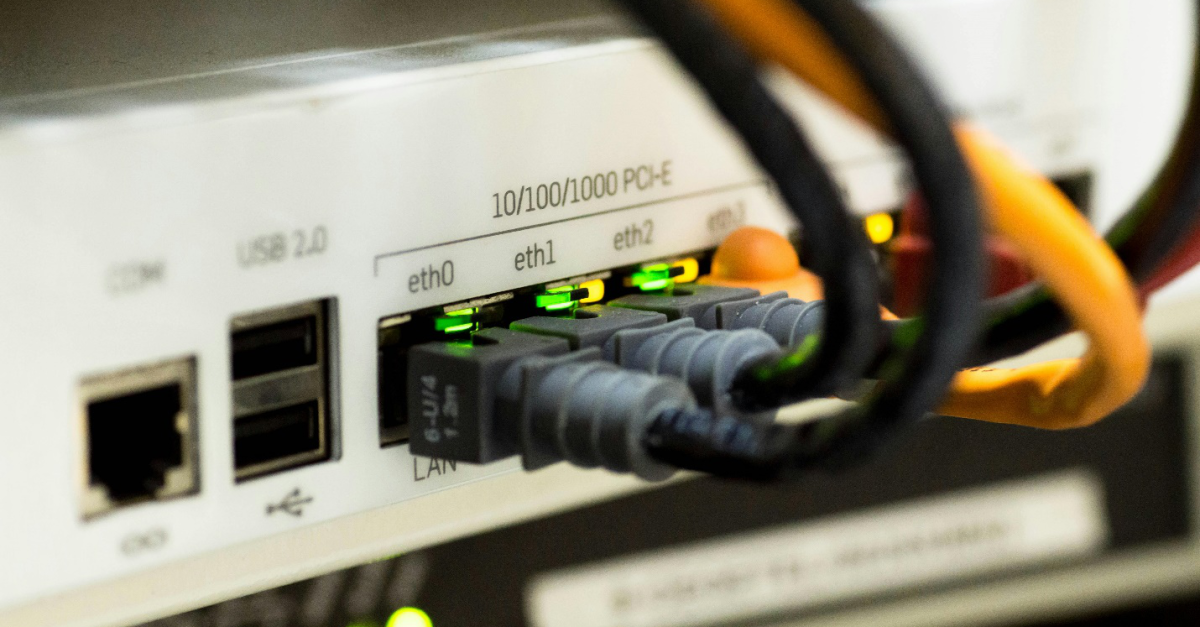The digital age is upon us, and a well-functioning network infrastructure and network infrastructure security are no longer a luxury but a necessity. It forms the backbone of any organization, connecting devices, facilitating communication, and enabling critical business operations. A secure and efficient network infrastructure ensures the smooth flow of data, protects sensitive information, and safeguards against costly downtime.
This comprehensive checklist will guide you through essential steps, including hiring Cyber Security Services, building and maintaining robust network infrastructure, and prioritizing both security and efficiency. It’s a valuable resource for businesses of all sizes, from small startups to established enterprises, ensuring their network remains a reliable and secure platform for success.
Understanding Network Infrastructure
Network infrastructure refers to the physical and logical components that enable devices to communicate and share resources across a network. It encompasses hardware elements like routers, switches, and firewalls, as well as software components such as operating systems and network protocols.
A well-designed network infrastructure is crucial for several reasons. First, it ensures smooth data flow, allowing users to access applications, share files, and collaborate seamlessly. Second, it provides the foundation for essential business services like email, VoIP communication, and cloud-based applications. Finally, a robust network infrastructure is the first step towards Network Infrastructure Security, protecting sensitive data from unauthorized access, cyberattacks, and data breaches.
Here’s a breakdown of some common network infrastructure components:
- Routers: These intelligent devices direct data traffic across different networks, ensuring it reaches the intended recipient efficiently.
- Switches: Switches connect devices within a network segment, allowing them to communicate directly with each other.
- Firewalls: Firewalls act as security barriers, monitoring incoming and outgoing traffic and filtering out malicious content to safeguard the network from cyber threats.
- Cabling: Network cables physically connect devices and transmit data. Choosing the right cable type and ensuring proper maintenance is crucial for optimal network performance.
- Network Operating Systems (OS): Network operating systems manage network resources, such as user access, security protocols, and network traffic.
The next section of this blog will delve deeper into the essential steps for creating a secure and efficient network infrastructure, equipping you with a comprehensive checklist for optimal network management.

Security Best Practices for a Robust Network Infrastructure
Building a secure and efficient network infrastructure goes hand-in-hand with implementing robust security measures. This section lays out essential best practices to fortify your Network Infrastructure Security and safeguard your valuable data from unauthorized access and cyber threats.
Access Control and Authentication: The First Line of Defence
The first line of defence in any security strategy involves controlling access to your network resources. Strong access control and authentication protocols ensure that only authorized users can access your network and sensitive data.
Read also: https://microsysinc.ca/ransomware-and-phishing-attacks_strategies-for-prevention-and-recovery/
Strong Passwords: Encourage users to create strong passwords utilizing a combination of upper and lowercase letters, numbers, and special characters. Implementing password complexity requirements and enforcing regular password changes further strengthens security.
Multi-Factor Authentication (MFA): MFA provides an essential level of protection surpassing mere passwords. It mandates users to authenticate their identity via a secondary method, like a code dispatched to their mobile device or a fingerprint scan, alongside the password. This makes it significantly harder for unauthorized individuals to gain access to your network, even if they manage to steal a password.
User Access Management: Define user access privileges based on the principle of least privilege. This ensures users only have access to the specific resources and applications they need to perform their jobs, minimizing the potential damage if a breach occurs.
Data Encryption: Safeguarding Data in Transit and at Rest
Data encryption scrambles information using a key, making it unreadable to unauthorized users. It plays a critical role in protecting sensitive data in two key scenarios:
- Data in Transit: This refers to data moving across the network, such as during email transmission or file downloads. Encrypting data in transit ensures that even if intercepted, it remains unreadable without the decryption key.
- Data at Rest: Data at rest refers to information stored on devices like hard drives or servers. Encrypting data at rest protects it from unauthorized access, even if a device is stolen or compromised.
There are various encryption technologies available, and a Managed IT Services Provider can help you choose the most suitable solutions for your specific needs. Implementing a data encryption strategy is essential for businesses dealing with sensitive information such as customer data, financial records, or intellectual property.

Firewall Configuration: Your Network's Guardian
Firewalls act as gatekeepers, monitoring and filtering incoming and outgoing network traffic. They can be configured to block suspicious activity, prevent unauthorized access attempts, and restrict access to certain websites or applications.
- Firewall Rules: Carefully configure firewall rules to allow legitimate traffic while blocking malicious activity. For example, blocking access to known phishing websites or high-risk ports can significantly reduce the risk of cyberattacks.
- Regular Reviews and Updates: Firewalls are not static tools. Regularly review firewall rules and update them as needed to reflect changes in your network environment or emerging threats. New vulnerabilities and attack techniques are constantly evolving, so keeping your firewall configuration up-to-date is critical.
Regular Software Updates and Patch Management: Addressing Vulnerabilities
Software vulnerabilities are weaknesses in software that cybercriminals can exploit to gain unauthorized access to a system. Keeping software and firmware on devices and network equipment updated is essential for maintaining a secure network infrastructure.
- Automated Patch Management: Implementing an automated patch management system ensures software updates are applied promptly, minimizing the window of opportunity for attackers to exploit vulnerabilities. This includes operating system updates, application updates, and firmware updates for network devices.
- Vulnerability Scanning: Regularly scan your network for vulnerabilities using vulnerability scanning tools. These tools identify potential weaknesses in your system and prioritize them based on severity, allowing you to address critical vulnerabilities first.
By following these security best practices, you can significantly enhance your Network Infrastructure Security and create a more robust foundation for your business operations. Remember, security is an ongoing process, not a one-time event. Continuously monitor your network for suspicious activity, stay updated on the latest security threats, and consider working with a Managed IT Services Provider or Cyber Security Services expert to build a comprehensive security strategy tailored to your specific needs.
Performance Optimization Strategies for a Seamless Network Experience
While security is paramount, a well-designed network infrastructure also needs to deliver optimal performance. This section explores key strategies to optimize your network and ensure a smooth and efficient user experience.

Bandwidth Management: Allocating Resources Wisely
Network bandwidth refers to the amount of data that can be transmitted across your network at a given time. Just like on a highway, bandwidth limitations can lead to congestion and slow data transfer speeds. Effective bandwidth management ensures optimal allocation of this crucial resource, preventing bottlenecks and maximizing network efficiency.
Traffic Shaping: Traffic shaping prioritizes specific types of network traffic over others. This can be beneficial for applications like video conferencing or VoIP calls, which require consistent bandwidth for smooth operation. By prioritizing these applications, you can ensure they don’t experience lag or disruption even when the network is busy with other activities.
Bandwidth Monitoring: Regularly monitor your network bandwidth usage to identify peak traffic times and applications consuming the most resources. This information helps you fine-tune your bandwidth allocation strategy and ensure critical business applications have the bandwidth they need to function optimally.
Quality of Service (QoS): While traffic shaping prioritizes specific types of traffic, Quality of Service (QoS) takes a more granular approach. QoS assigns different levels of priority to individual data packets, ensuring critical applications receive the bandwidth they need for consistent performance. For example, a video conference call would receive higher QoS priority compared to a regular file download.
Quality of Service (QoS) Implementation: Prioritizing Performance
Quality of Service (QoS) refines network efficiency by prioritizing specific types of network traffic. While bandwidth allocation ensures there’s enough overall capacity, QoS guarantees a consistent level of performance for applications that require it.
QoS Policies: Implement QoS policies to define how network traffic is prioritized. These policies can be based on factors like application type, user role, or protocol. For instance, a business might prioritize real-time communication applications like VoIP calls over email traffic, ensuring a smooth and uninterrupted communication experience.
QoS Configuration: Network devices like routers and switches can be configured to support QoS functionalities. By configuring QoS rules, you can prioritize specific traffic flows and ensure critical applications consistently receive the bandwidth they require for optimal performance.

Network Monitoring and Troubleshooting: Proactive Maintenance
Just like a car engine, your network infrastructure requires regular monitoring and maintenance to ensure it runs smoothly. Network monitoring tools provide valuable insights into network performance, allowing you to identify and address potential issues before they escalate and disrupt business operations.
Network Monitoring Tools: Implementing network monitoring tools allows you to track key metrics like network traffic, bandwidth usage, device performance, and error rates. These tools generate alerts when anomalies or potential issues are detected, enabling proactive intervention.
Network Performance Analysis: Regularly analyze network performance data to identify trends and patterns. This can help you pinpoint potential bottlenecks, optimize configurations, and ensure your network infrastructure can accommodate future growth.
Troubleshooting Techniques: When network performance issues arise, it’s crucial to have a systematic approach to troubleshooting. This may involve isolating the problem area, checking for device errors, or verifying cable connections. Managed IT Services Providers can offer valuable expertise in network troubleshooting and problem resolution.
The Synergy Between Network Infrastructure Security and Performance
It’s important to remember that Network Infrastructure Security and performance optimization are not mutually exclusive concepts. In fact, they work together to create a robust and reliable network environment.
For instance, security measures like firewalls can sometimes impact network performance by adding an extra layer of processing. However, a well-configured firewall can minimize this impact while still safeguarding your network from threats. Similarly, keeping software updated with the latest security patches can improve overall network stability by addressing vulnerabilities that could be exploited by malicious actors.
By implementing a combination of security best practices and performance optimization strategies, you can create a network infrastructure that is both secure and efficient, enabling your business to thrive in today’s digital landscape. Consider partnering with a Managed IT Services Provider or a Cyber Security Services expert to gain access to specialized expertise and ensure your network infrastructure meets the evolving needs of your organization.
Checklist for Secure and Efficient Network Infrastructure
Safeguard your business with a robust network infrastructure. This checklist summarizes key practices to ensure both security and efficiency:
Network Infrastructure Security
- Access Controls: Enforce strong passwords, implement Multi-Factor Authentication (MFA), and manage user access privileges.
- Data Encryption: Encrypt data at rest and in transit to protect sensitive information.
- Firewall Configuration: Configure firewalls to block suspicious activity and update them regularly.
- Software Updates: Maintain a regular update schedule for software and firmware to address vulnerabilities.
- Network Monitoring: Proactively monitor your network for suspicious activity and performance issues with dedicated tools.
Performance Optimization
- Bandwidth Management: Allocate bandwidth strategically, prioritizing critical applications with traffic shaping and QoS.
- Quality of Service (QoS): Implement QoS policies to ensure consistent performance for essential applications.
- Network Performance Analysis: Regularly analyze network data to identify bottlenecks and optimize configurations.

Take Action Today
Building and maintaining a secure and efficient network infrastructure is crucial for any business. Microsys, your trusted Managed IT Services Provider, can assist you in implementing these best practices.
Our team of experts can assess your network needs, recommend optimal solutions, and ensure your organization leverages a reliable and secure foundation for success. Contact Microsys today to discuss how we can help you with network infrastructure security through our Cyber Security Services and more.
Schedule a consultation to learn about our approach.



